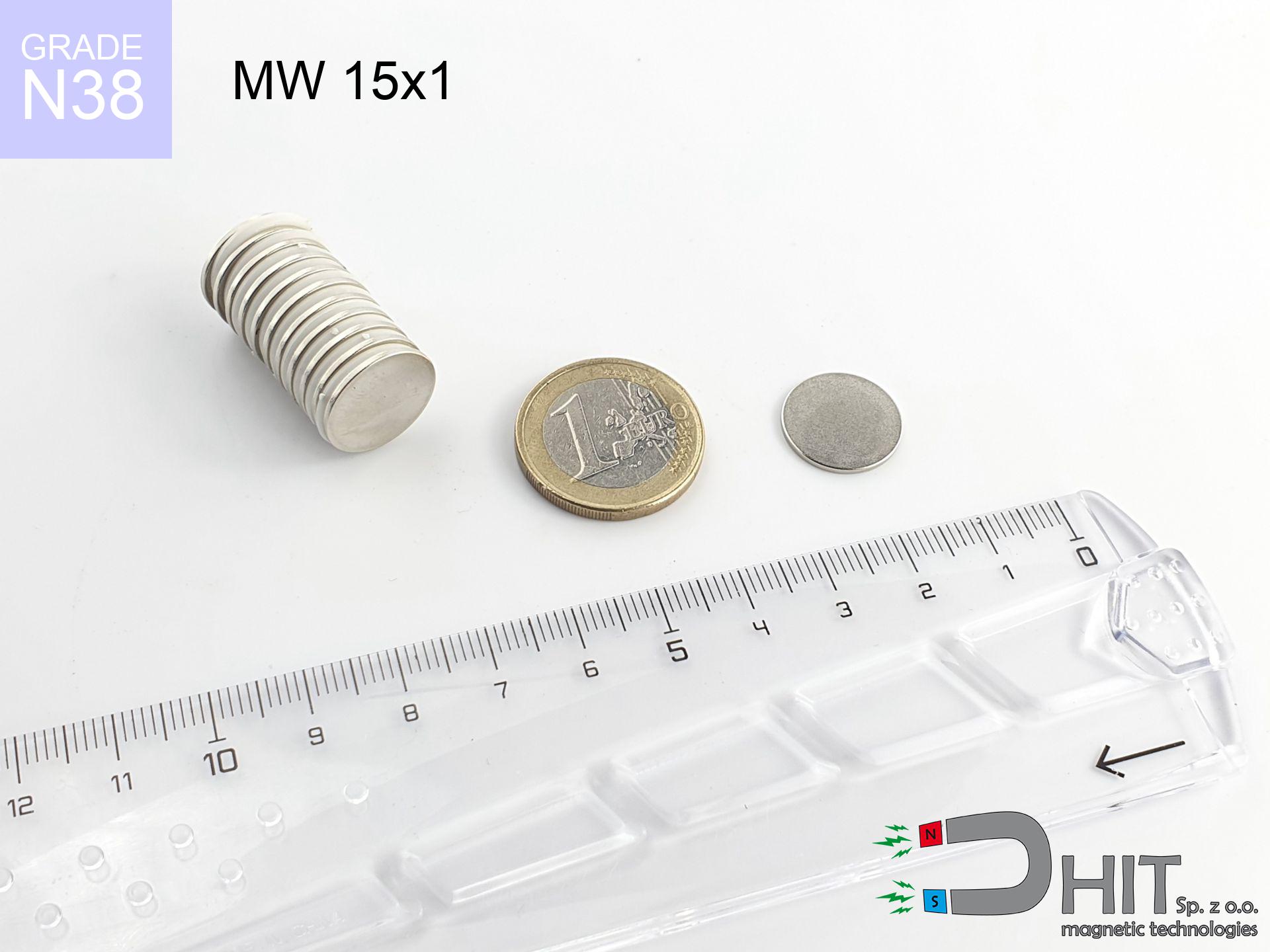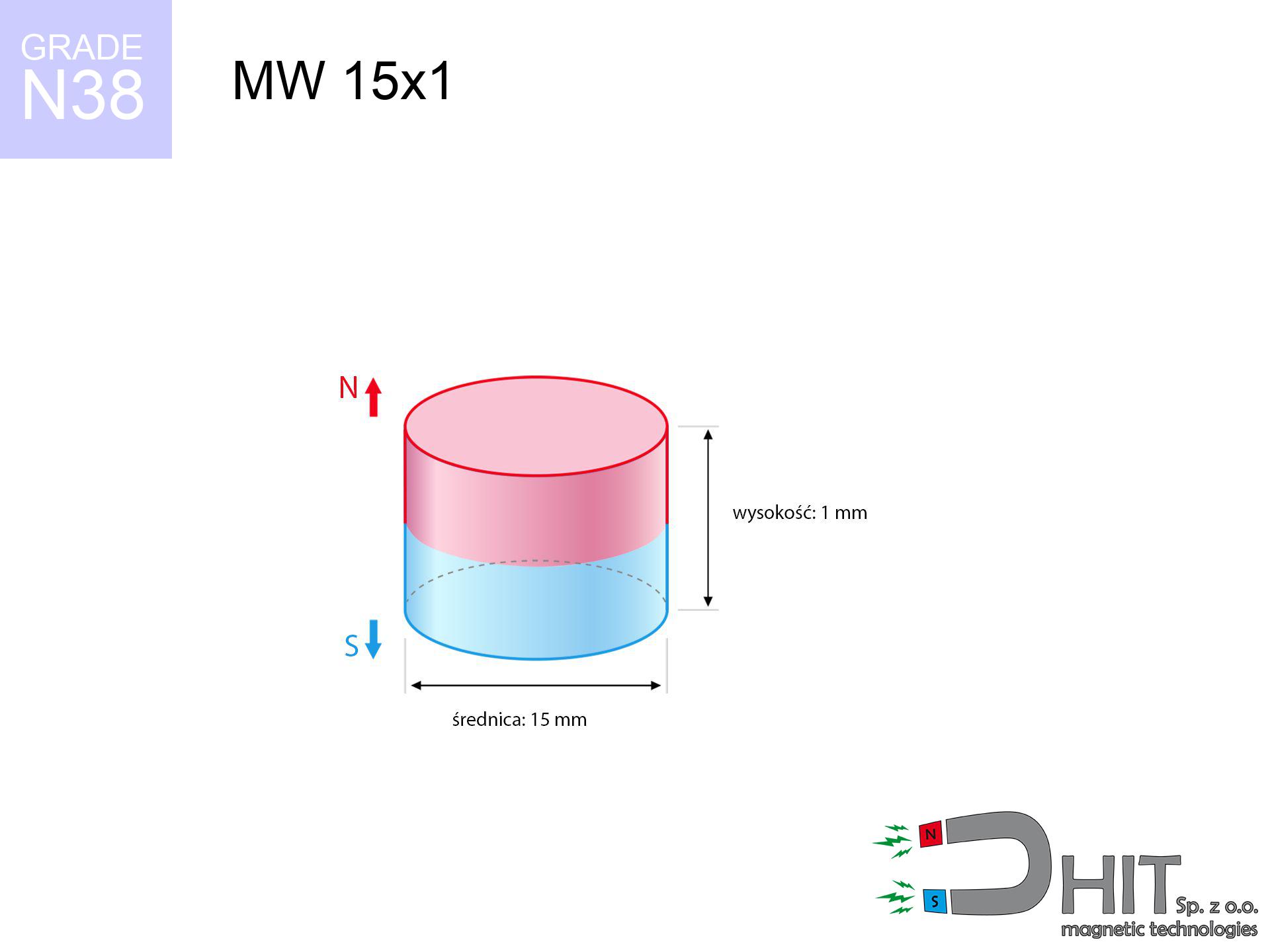MW 15x1 / N38 - cylindrical magnet
cylindrical magnet
Catalog no 010026
GTIN: 5906301810254
Diameter Ø
15 mm [±0,1 mm]
Height
1 mm [±0,1 mm]
Weight
1.33 g
Magnetization Direction
↑ axial
Load capacity
0.83 kg / 8.14 N
Magnetic Induction
81.93 mT
Coating
[NiCuNi] nickel
0.800 ZŁ with VAT / pcs + price for transport
0.650 ZŁ net + 23% VAT / pcs
bulk discounts:
Need more?Want to negotiate?
Call us
+48 888 99 98 98
otherwise contact us via
our online form
the contact form page.
Weight along with appearance of magnets can be reviewed with our
our magnetic calculator.
Same-day shipping for orders placed before 14:00.
Magnetic properties of material N38
Physical properties of sintered neodymium magnets Nd2Fe14B at 20°C
Shopping tips
Advantages and disadvantages of rare earth magnets.
Besides their exceptional strength, neodymium magnets offer the following advantages:
- They virtually do not lose power, because even after 10 years the performance loss is only ~1% (based on calculations),
- They retain their magnetic properties even under external field action,
- The use of an refined coating of noble metals (nickel, gold, silver) causes the element to present itself better,
- Magnetic induction on the surface of the magnet turns out to be extremely intense,
- Due to their durability and thermal resistance, neodymium magnets can operate (depending on the shape) even at high temperatures reaching 230°C or more...
- Thanks to modularity in constructing and the ability to modify to complex applications,
- Key role in high-tech industry – they are commonly used in data components, electromotive mechanisms, diagnostic systems, also multitasking production systems.
- Compactness – despite small sizes they offer powerful magnetic field, making them ideal for precision applications
Cons of neodymium magnets: weaknesses and usage proposals
- They are fragile upon heavy impacts. To avoid cracks, it is worth protecting magnets in a protective case. Such protection not only protects the magnet but also improves its resistance to damage
- We warn that neodymium magnets can reduce their power at high temperatures. To prevent this, we advise our specialized [AH] magnets, which work effectively even at 230°C.
- Due to the susceptibility of magnets to corrosion in a humid environment, we advise using waterproof magnets made of rubber, plastic or other material stable to moisture, in case of application outdoors
- Limited possibility of producing threads in the magnet and complicated shapes - preferred is a housing - magnetic holder.
- Possible danger resulting from small fragments of magnets pose a threat, when accidentally swallowed, which is particularly important in the context of child health protection. It is also worth noting that small components of these devices can disrupt the diagnostic process medical when they are in the body.
- With large orders the cost of neodymium magnets is economically unviable,
Best holding force of the magnet in ideal parameters – what it depends on?
The load parameter shown refers to the maximum value, measured under ideal test conditions, namely:
- using a sheet made of high-permeability steel, serving as a ideal flux conductor
- whose thickness equals approx. 10 mm
- with a plane cleaned and smooth
- with total lack of distance (no impurities)
- for force applied at a right angle (pull-off, not shear)
- at conditions approx. 20°C
Key elements affecting lifting force
Real force is affected by specific conditions, such as (from most important):
- Distance (between the magnet and the metal), as even a tiny distance (e.g. 0.5 mm) leads to a decrease in force by up to 50% (this also applies to paint, corrosion or dirt).
- Pull-off angle – note that the magnet holds strongest perpendicularly. Under shear forces, the holding force drops drastically, often to levels of 20-30% of the nominal value.
- Metal thickness – the thinner the sheet, the weaker the hold. Part of the magnetic field penetrates through instead of converting into lifting capacity.
- Steel type – low-carbon steel gives the best results. Alloy admixtures reduce magnetic properties and holding force.
- Plate texture – ground elements guarantee perfect abutment, which increases force. Uneven metal weaken the grip.
- Heat – NdFeB sinters have a sensitivity to temperature. At higher temperatures they lose power, and at low temperatures they can be stronger (up to a certain limit).
* Holding force was tested on the plate surface of 20 mm thickness, when the force acted perpendicularly, in contrast under parallel forces the holding force is lower. In addition, even a minimal clearance {between} the magnet and the plate lowers the holding force.
Safe handling of neodymium magnets
Keep away from electronics
Be aware: rare earth magnets produce a field that disrupts precision electronics. Maintain a separation from your phone, tablet, and GPS.
ICD Warning
Warning for patients: Strong magnetic fields affect electronics. Maintain minimum 30 cm distance or ask another person to handle the magnets.
Electronic hazard
Data protection: Strong magnets can damage data carriers and sensitive devices (pacemakers, medical aids, mechanical watches).
Pinching danger
Pinching hazard: The pulling power is so immense that it can result in hematomas, pinching, and even bone fractures. Use thick gloves.
Thermal limits
Keep cool. NdFeB magnets are susceptible to heat. If you need operation above 80°C, ask us about special high-temperature series (H, SH, UH).
Product not for children
Only for adults. Tiny parts can be swallowed, causing severe trauma. Store out of reach of kids and pets.
Conscious usage
Handle magnets consciously. Their huge power can shock even professionals. Be vigilant and do not underestimate their force.
Mechanical processing
Machining of NdFeB material carries a risk of fire risk. Magnetic powder oxidizes rapidly with oxygen and is difficult to extinguish.
Allergy Warning
Allergy Notice: The nickel-copper-nickel coating consists of nickel. If an allergic reaction occurs, cease handling magnets and wear gloves.
Beware of splinters
Despite metallic appearance, neodymium is brittle and cannot withstand shocks. Avoid impacts, as the magnet may crumble into hazardous fragments.
Attention!
Details about hazards in the article: Safety of working with magnets.




![SM 18x100 [2xM5] / N42 - magnetic separator SM 18x100 [2xM5] / N42 - magnetic separator](https://cdn3.dhit.pl/graphics/products/sm-18x100-2xm5-pem.jpg)




